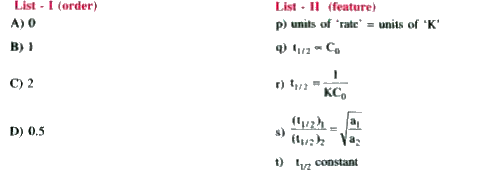SO2 reacts with O2 as follows 2SO2+O2→2SO3, the rate of disappearance of SO2 is 2.4×10−4 mole lit−1min−1. Then Solution in Telugu
Rate of reaction is .2×10−4 mole lit−1min−1
Rate of apprance of SO3 is 2.4×10−4 mole lit−1min−1
Rate of disppearance of O2 is 1.2×10−4 mole lit−1min−1
Rate of reaction is twice the rate of disappearance of SO3.
The correct Answer is:A, B, C
r=rSO22=rO22,rSO2=2.4×10−4
Topper's Solved these Questions
- BOOK - AAKASH SERIESCHAPTER - CHEMICAL KINETICSEXERCISE - LEVEL-II(LECTURE SHEET EXERCISE-II LINKED COMPREHENSION TYPE QUESTIONS)9videos
CHEMICAL KINETICS
- BOOK - AAKASH SERIESCHAPTER - CHEMICAL KINETICSEXERCISE - LEVEL-II(LECTURE SHEET EXERCISE-III MATCH THE FOLLOWING QUESTIONS)3videos
CHEMICAL KINETICS
- BOOK - AAKASH SERIESCHAPTER - CHEMICAL KINETICSEXERCISE - LEVEL-1 (EXERCISE -II ORDER, MOLECULARITY, HALF LIFE:)34videos
CHEMICAL KINETICS
- BOOK - AAKASH SERIESCHAPTER - CHEMICAL KINETCSEXERCISE - EXERCISE - 3.245videos
CHEMICAL KINETCS
- BOOK - AAKASH SERIESCHAPTER - CHEMICAL THERMODYNAMICSEXERCISE - Additional Practice Exercise54videos
CHEMICAL THERMODYNAMICS
Similar Questions
A certain endothermic reaction: A→ Product, ΔH=+ve proceeds ina sequence of three elementary steps with the rate constant K1,K2 and K3 and each one having energy of activation E1,E2 and E3 respectively at 25∘C. The observed rate constannt for the reaction is equal to K3√K1K2.
A1,A2 and A3 are Arrhenius parameters respectively.
The observed energy of activation for the reaction is03:47View SolutionMatch the following columns
 03:19View Solution
03:19View SolutionSucrose decompose in acid solution into glucose and fructose according to the first order rate law, with t12=3.00 hours. What fraction of sample of sucrose remains after 8 hours ?
03:30View SolutionDiscuss on the kinetic spontaneity of a chemical reaction. Is a slow reaction spontaneous? Why?
03:43View SolutionWhich among the following is not an exact differential?
04:56View SolutionThe rate of formation of SO3 in the following reaction: 2SO2+O2→2SO3 is 10gsec−1. The rate of disappearance of O2 will be
View SolutionThe rate of disappearance of SO_(2) in the reaction 2SO_(2) + O_(2) rarr 2SO_(3) is 1.28 xx 10^(-3) g//sec then the rate of formation of SO_(3) is
View SolutionThe rate of formation of SO3 in the reaction
2SO2+O2→2SO3
is 100 g min−1 Hence rate of disappearance of O2 is02:31View SolutionRate of formation SO_(3) in this reaction is 1.6xx10^(-3)kg//min 2SO_(2)+O_(2)to2SO_(3) then rate at which SO_(2) reacts is :-
01:49View Solution2SO_(2)+O_(2)hArr 2SO_(3) . Starting with 2 moles SO_(2) and 1 mole O_(2) in 1L flask, mixture required 0.4 mole MnO_(4)^(-) in acidic medium. Hence, K_9c) is
02:33View SolutionThe rate of disappearence of SO_(2) in the reaction 2SO_(2)+O_(2)to2SO_(3) is 1.28xx10^(-3) g litre^(-1) sec^(-1) Then the rate of formation of SO_(3) in g litre^(-1) sec^(-1) is
02:27View SolutionFor a reaction 2SO2+O2<⇒2SO3, rate of disappearance of O2 is 2×10−4 mol L−1. The rate of appearance of SO3 is:
02:33View SolutionIn the reaction, 2SO_(2) +O_(2) to 2SO_(3) when 1 mole of SO_(2) and 1 mole of O_(2) are made to react to completion
02:27View Solution10 moles of SO_(2) and 4 moles of O_(2) are mixed in a closed vessel of volume 2 litres. The mixture is heated in the presence of Pt catalyst. Following reaction takes place: 2SO_(2)(g)+O_(2)(g)to2SO_(3)(g) Number of moles of SO_(3) formed in the reaction will be
02:54View SolutionThe rate of formation of SO_(3) in the reaction 2SO_(2)+O_(2)to2SO_(3) is 100 g "min"^(-1) Hence rate of disappearance of O_(2) is
03:00View Solution

